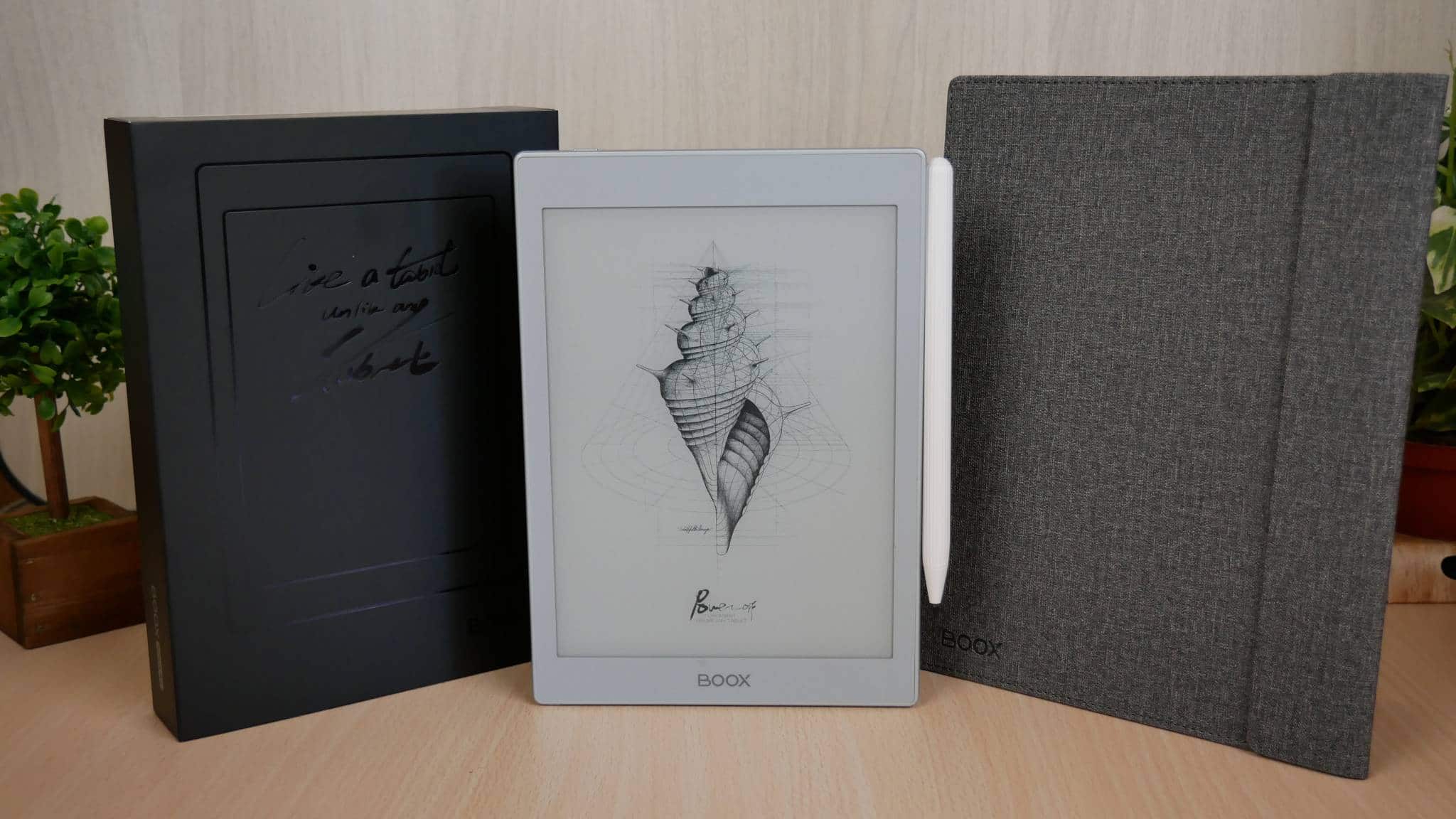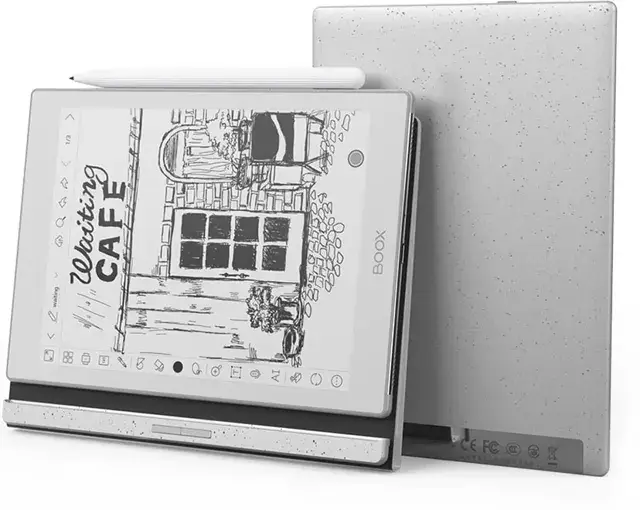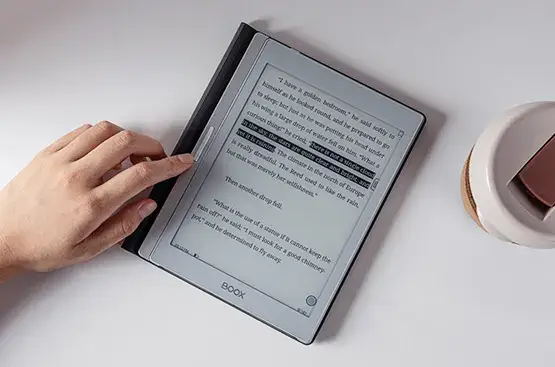The Onyx Boox Nova Air is a brand new E INK based digital note taking device and ebook reader. It has a black and white display, and high DPI, so it is easy on the eyes and can be used outdoors, with no glare. It is running Google Android 10 and has full access to the Play Store. There is more than meets the eye with the Nova Air, despite it being thinner and lighter than the Nova 3. You can purchase the Nova Air from Good e-Reader for $349.99.
Hardware
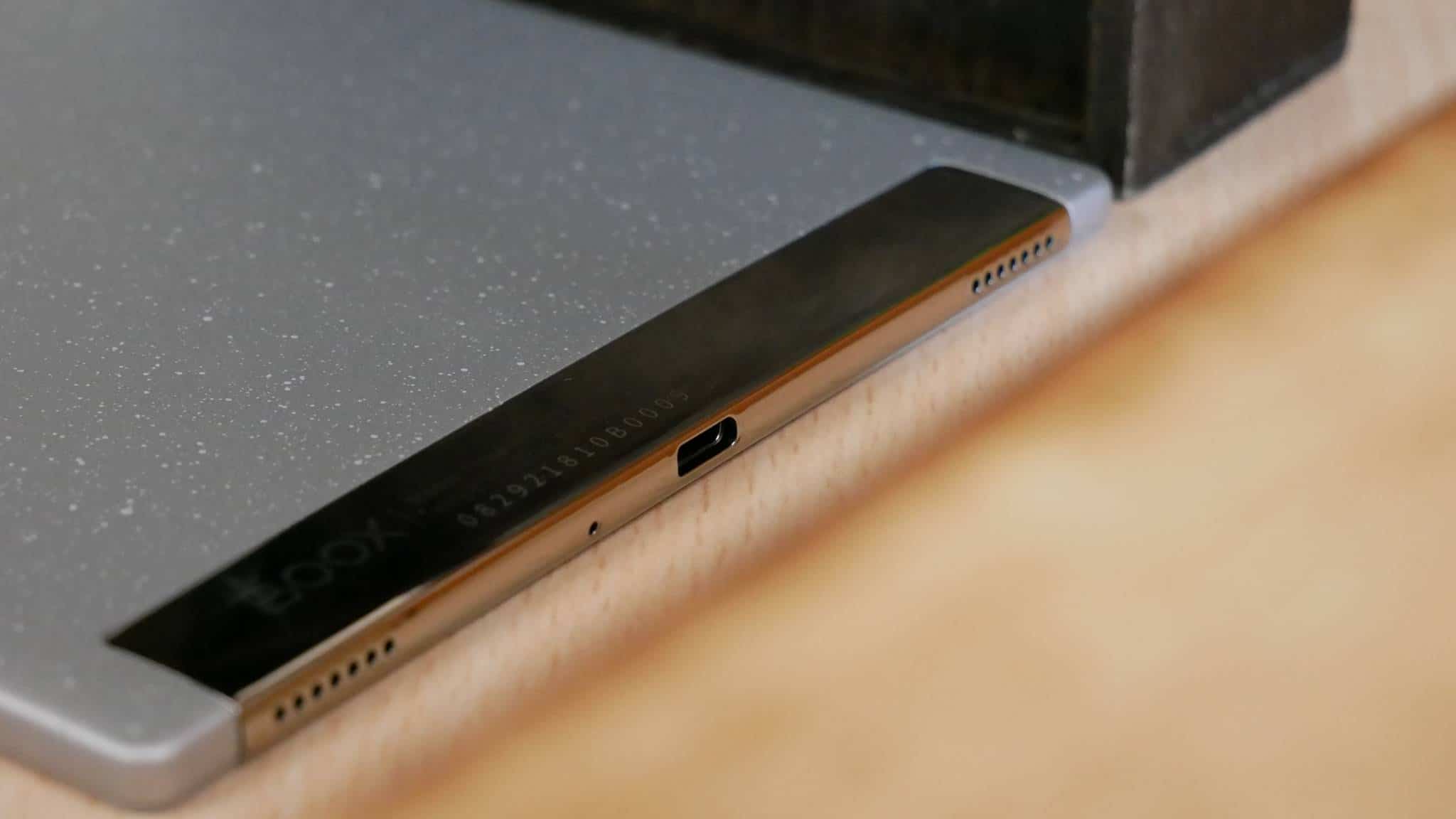
The Nova Air features a 7.8 inch E INK Carta HD capacitive touchscreen display with a resolution of 1872×1404 with 300 PPI. There is a WACOM layer, which means you can use a stylus to take notes, edit PDF files or interact with the UI. There is a front-lit display with white LED lights and a color temperature system with Amber LED lights. This lighting system can be combined, to provide soft warm light, when reading at night. The overall color scheme of the product is silver/grey. It has a chrome strip on the very bottom on the back, which adds a bit of contour. The back, has a ton of grip, and does not easily leave fingerprints, although the chrome strip does.
There is a new screen protector that is grated on the display at the factory. When you take the device out of the box for the first time there is a warning sticker that says this should not be removed. This screen protector helps add a bit of torque to the accompanied stylus, when you are drawing on the screen. This is the only Onyx product to ever do this. Onyx has also developed a premium case that has manual page turn buttons and connect to the Air using pogo connectors. It opens and closes via magnetic clasps which puts the Air to sleep when you close it, helping preserve battery life. When you open it, it wakes it up.
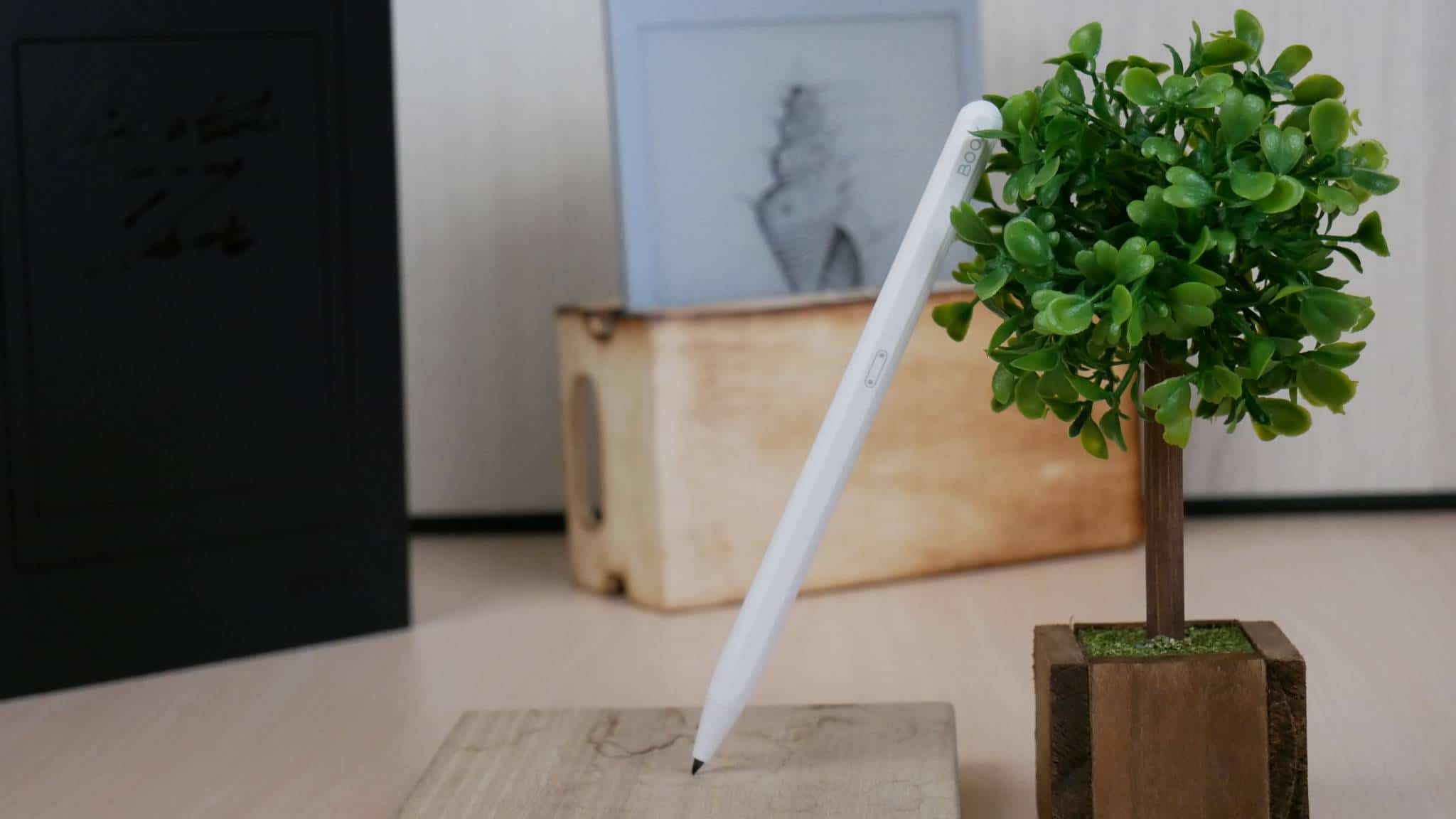
Speaking of stylus, Onyx has developed a new white stylus, that is not triangular, but hexagonal and has 4096 degrees of pressure sensitivity. The nibs jut out a little bit more than their typical black stylus that ships with all of their other products. I found that this new stylus helps with drawing, offering pin point precision. The right side of the Nova Air is magnetic, so the stylus will automatically attach itself.
Underneath the hood is a Snapdragon 636 Octa core processor, 3GB of RAM and 32GB of internal storage. You can connect up to the internet using WIFI and it supports wireless headphones or an external speaker for audiobooks, music, podcasts and more, thanks to Bluetooth 5.0. If you don’t feel like using headphones, there is two stereo speakers, which has amazing sound. There is a USB-C port, which is useful for charging the e-Reader to your PC or MAC, or even a wall charger. It is powered by a 2000 mAh battery, which should be good for a couple of weeks of regular use. The dimensions are 194×136.5×6.3 mm and weighs 235g.
I really like the overall design of the Nova Air, the color scheme makes it stand out in a world full of piano black e-readers. I like the magnetic sides that allow the pen to clasp to it and dig the palm rejection technology, so you can draw without errant touchscreen interactions. It is thinner and lighter than the Nova 3.
Software
The Nova Air is employing Google Android 10, which is as modern as your going to get with E INK products. It comes with a slew of security features that are updated automatically, without having to download them from Google. Many digital note taking devices do not have any type of app store preinstalled, they basically force users to source their own apps or disable sideloading altogether. Onyx has Google Play, but you need to do a few things to get it installed properly. We have a great video tutorial that walks you through the entire setup process, it is easy to follow along. Onyx also operates their own app store, but there are less than 50 on it, but it’s enough to get you started.
Onyx has their own fork of Android, which they use to provide a customized experience. They have a dedicated launcher app, that makes all of the UI elements and buttons easy to press down on. The main UI gives you the library, settings menu, apps drawer, note taking app and bookstore. There are also a bunch of typical Android functions, such as swiping downwards from the top of the screen to view your notifications, configure your wireless network and other settings.
There are a number of advanced settings that are important to note. You can change your global contrast levels, which means you can make black text darker or turn the background to darker shades of grey. There are also various speed modes you can employ that tremendously improves the performance. This is important if you intend on playing games that have lots of animations or use e-reading apps that were designed for smartphones, such really nice page turns. Maybe you want to make scrolling around on the Play Store more fluid and ditto with browsing the web. The default mode is reading mode, this provides a very clean experience, great for reading ebooks, changing settings or drawing. A2 mode is good for editing PDF files, this option subtly degrades image quality, with a boost to performance. Speed mode is an elevated form of A2, it is good for surfing the internet, accessing the Play Store or playing complex animations in apps, such as the animated page turns in Kobo or Overdrive Libby. X-Mode is ideal for really upping the framerate, so you can play games or watch Youtube videos. Some of the different modes have their drawbacks, such as ghosting on the screen, there is a drop down option to refresh the entire screen to remove it.
The main home screen has a persistent radial dial, which when clicked on, provides a number of shortcuts. There are six default ones, from launching individual apps or doing a full page refresh. It can be positioned anywhere you want, or disabled entirely. The dials can be customized and do different things, anything from launching apps to various system settings. If you find yourself jumping between different menus to access the same things, you can link them to the dial to save time.
Onyx has really refined the concept providing a multimedia tablet experience on an E INK screen and also providing a robust note taking experience. The Nova Air is not a one trick pony, that just does one or two things really well, but can do a bunch of different things. It is ideal for people who want more out of an e-reader, but they want to take notes, use Google Play apps and get higher performance. I really like the split screen view, so you can work on two different things at the same time, this includes books, notes, apps, drawings etc.
Drawing and Writing
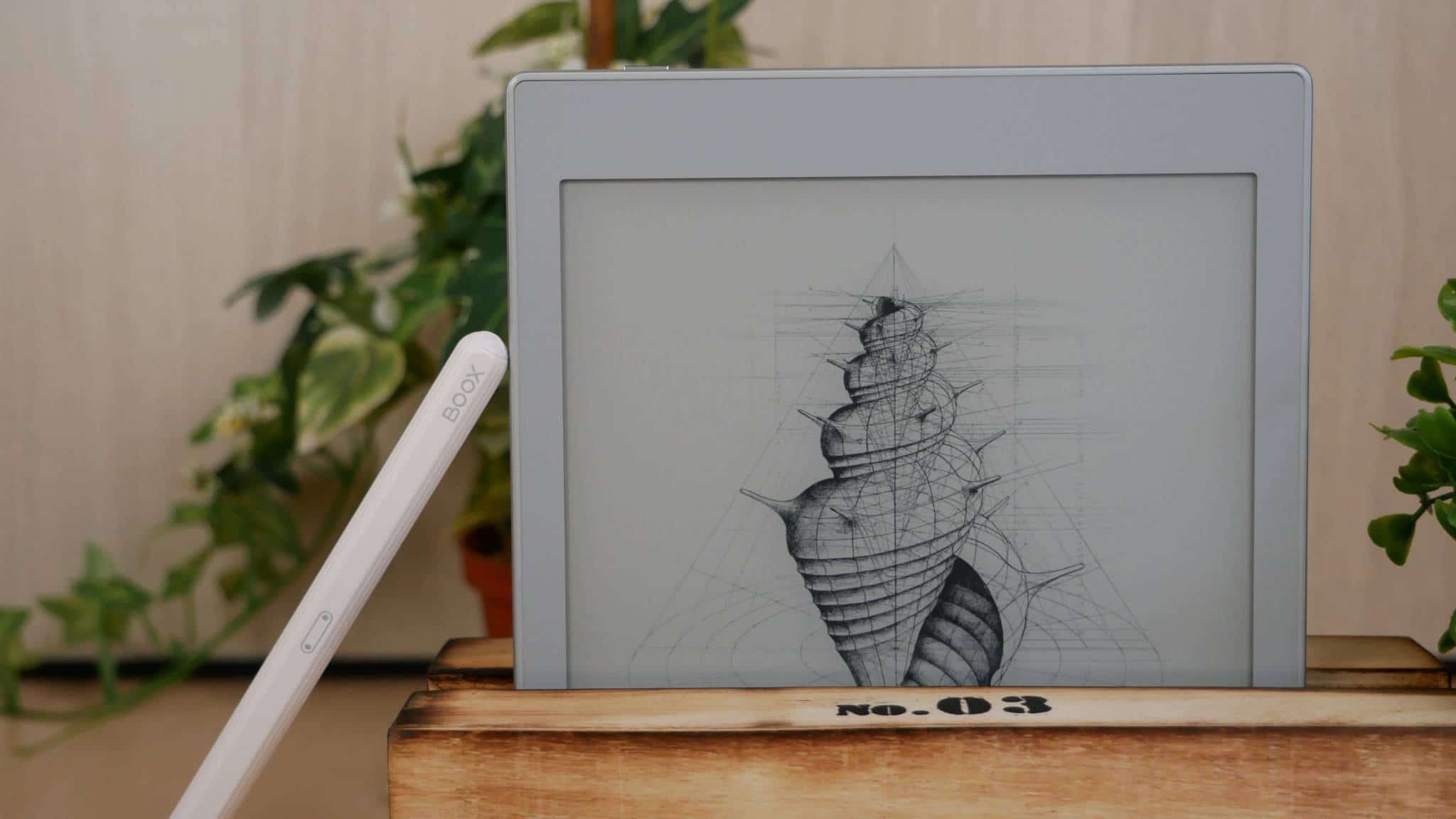
One of the best things about the Onyx Boox Nova Air is the sheer amount of features they have added to the writing experience. Similar to the Remarkable 2 and Supernote, there are layers. This allows you to for example use layer 1 as some grass, layer 2 the sky and layer 3 a house. When you are on layer 3, and decide you want to erase something, it will not affect layer 1 or 2, which really makes the Air shine has a tool for artists, game designers, and other professions.
When you want to draw something there is a slew of pens and pencils, and even other tools like a mechanical pencil and highlighter, fountain pen, paint brush, ballpoint pen or text. There is also line thickness settings to get thinner or thicker lines, but don’t forget, the Air has pressure sensitivity too. You can select black, grey, medium grey, light grey, white, red, green and blue. The colors will not show on accurately on the E INK display, because the Nova Air has a B&W display, and not color. If you want to draw in RGB you can simply export your notes/drawings as a PNG or PDF file and copy it it to your PC/MAC. Once it is opened on your computer, you can view the document in full color. This is useful for teachers who are grading students material.
The Nova Air basically allows you to export notes to your PC/MAC in PNG or PDF and also from your PC/MAC to your computer. But what else can it do? You can screencast whatever is on your Note 3 directly to your PC. This is useful during meetings or to show people what you have been working on, rather than crowding around the e-reader. Onyx also has a companion app Android and they are working on an IOS version. This is optional to use. It lets you sync everything on the Nova 3 to your smartphone or from your smartphone to the Note. Onyx also provides 1GB of cloud storage for everything stored in their own cloud. You only need to use the companion app if you want smartphone integration.
The overall writing experience on the Air is solid, but does not offer super advanced features that the Remarkable 2 or Supernote offers. This might be a good thing for most users who are new to e-notes, because the learning curve is not as pronounced. It offers enough tools to to take notes or freehand draw and do quality work. The Air is for the everyman.
Wrap Up
I think the Nova Air is likely the best 7.8 inch e-reader and e-note that you can buy in 2021. The Onyx software is rock solid, the company pushes out firmware updates regularly, introducing new features and bug fixes. The speed modes they offer are best in the business and dramatically increase the performance of Android apps, which you can download from the Play Store. Basically, Onyx and Boyue are the only two companies in the world that offer Play on their devices, which sure beats sideloading.
The note taking experience is great, without being overly complicated, editing PDF files is the same as freehand drawing, you get the same UI overlays. Although a 7.8 won’t really give you the best PDF editing experience, you would need at least a 10.3 inch screen or ideally a 13.3.
Should you buy the Nova Air? It provides more value than the Nova 3, and if you are looking for a purely black and white device, this is better. If you were to ask me what Onyx 7.8 is the best right now? I think the Nova 3 Color is the better buy. Color has come a long way since it first debuted in e-readers back in 2011, there have been major advancements and Onyx currently offers the best color e-reader in the market.
Michael Kozlowski is the editor-in-chief at Good e-Reader and has written about audiobooks and e-readers for the past fifteen years. Newspapers and websites such as the CBC, CNET, Engadget, Huffington Post and the New York Times have picked up his articles. He Lives in Vancouver, British Columbia, Canada.

